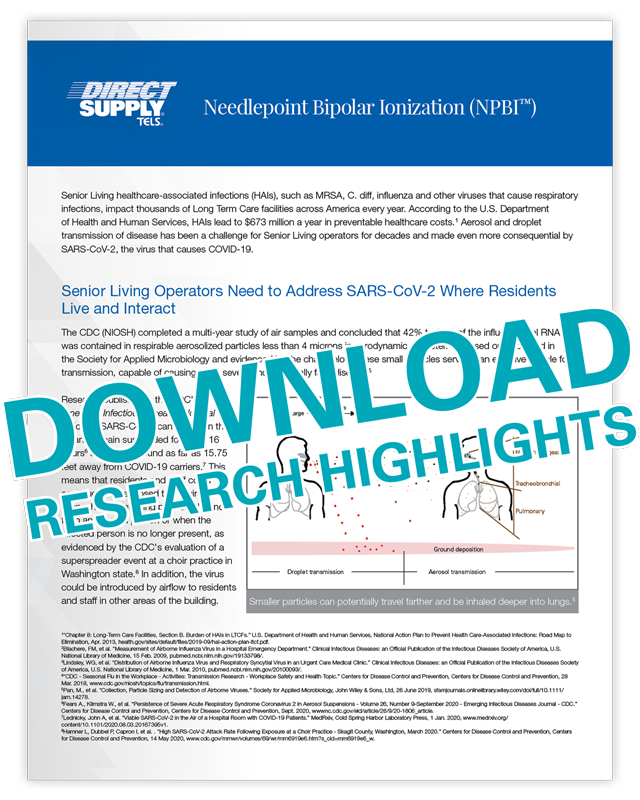Needlepoint Bipolar Ionization
Reduce certain viruses, bacteria, and odors by delivering the clean air benefits of Needlepoint Bipolar Ionization (NPBI™). From specification to installation and post-install ion monitoring, the expert team at Direct Supply TELS will handle every detail for you.
Poor Indoor Air Quality Has Far-Reaching Effects
53%
of influenza particulate
is aerosolized
(airborne)1
81%
of Senior Living Buildings have insufficient HVAC systems3
Break the Chain of Infection
Reduce airborne particles including certain odors, viruses, and bacteria.
Needlepoint Bipolar Ionization (NPBI) technology
inactivates up to
98.33%
of SARS-CoV-2 in lab tests*
Up to
41%
Reduced Risk
of COVID-19 infection in buildings with
NPBI installed**
* Inactivation results based on sensitivity testing conducted by independent third-party testing laboratory using control chambers. Multiple data points are used to formulate performance validation statements. The technology is used in a wide range of applications across diverse environmental conditions. Results in non-lab environments will vary; clients should evaluate their individual application and environmental conditions when making an assessment regarding the technology’s potential benefits. For all independent laboratory results, contact your TELS Representative at IndoorAirQuality@Directs.com. The use of this technology is not intended to take the place of reasonable precautions to prevent the transmission of pathogens (including COVID-19). Comply with all applicable public health laws and guidelines as well as CDC guidance (https://www.cdc.gov/coronavirus/2019-ncov/prevent-getting-sick/prevention.html).

Get the science behind it. Contact us to download our research summary.
Use NPBI to Boost Census
Decals and stickers to display in prominent areas of your building
Leave Every Detail to Us
We’ve installed NPBI in hundreds of Senior Care facilities across the country. The process is simple:

1
Fill out NPBI worksheet and return to Direct Supply

2

3
Request Your Free Quote
Fill out your information and a Direct Supply NPBI Specialist will respond quickly.
Explore Trending Topics
1“CDC – Seasonal Flu in the Workplace – Activities: Transmission Research – Workplace Safety and Health Topic.” www.cdc.gov, 17 Apr. 2020, www.cdc.gov/niosh/topics/flu/transmission.html. Accessed 1 July 2020. • 2 Prather, Kimberly A., et al. “Reducing Transmission of SARS-CoV-2.” Science, 27 May 2020, p. eabc6197, 10.1126/science.abc6197. Accessed 11 June 2020. • 3 National Library of Medicine. “81% of Senior Living Buildings have insufficient HVAC systems”, https://pubmed.ncbi.nlm.nih.gov/33401060. • 4 “Indoor Air Quality.” EPA, Environmental Protection Agency, 16 July 2018, www.epa.gov/report-environment/indoor-air-quality.
